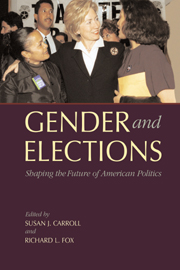Book contents
- Frontmatter
- Contents
- List of Figures, Text Boxes, and Photo
- List of Tables
- Acknowledgments
- List of Contributors
- Introduction: Gender and Electoral Politics into the Twenty-First Century
- 1 Presidential Elections
- 2 Voter Participation and Turnout
- 3 Voting Choices
- 4 Congressional Elections
- 5 African American Women and Electoral Politics
- 6 Political Parties and Women's Organizations
- 7 Advertising, Web Sites, and Media Coverage
- 8 State Elections
- Index
2 - Voter Participation and Turnout
It's a New Game
Published online by Cambridge University Press: 05 June 2012
- Frontmatter
- Contents
- List of Figures, Text Boxes, and Photo
- List of Tables
- Acknowledgments
- List of Contributors
- Introduction: Gender and Electoral Politics into the Twenty-First Century
- 1 Presidential Elections
- 2 Voter Participation and Turnout
- 3 Voting Choices
- 4 Congressional Elections
- 5 African American Women and Electoral Politics
- 6 Political Parties and Women's Organizations
- 7 Advertising, Web Sites, and Media Coverage
- 8 State Elections
- Index
Summary
Women make up a majority of the U.S. voting age population, registered voters, and actual voters. These facts explain why both major political parties – Democrats and Republicans – and women's advocacy groups from across the ideological spectrum worked harder to mobilize women voters in 2004 than in the past. Women's votes were viewed as critical to victory, and getting women to the polls became a key strategy.
Women's dominance at the ballot box is a relatively recent phenomenon. Women did not possess the right to vote in all the states until 1920, with the ratification of the Nineteenth Amendment to the U.S. Constitution. Since then, “We've come a long way, baby” [“sister,” “mama,” “grandma”].
But it's not far enough yet, say political activists who pushed for greater female involvement in the 2004 campaign. Thanks to these crusaders, both the Democratic and Republican National Committees beefed up their efforts to educate, mobilize, and support women voters.
Outside the political parties, women's advocacy groups sprang into action – first to get more women registered, and then to get them to the polls. Groups ranged from the more traditional, and nonpartisan, League of Women Voters (founded in 1919) to new ones with catchy, sassy names like MTV's Chicks Rock, Chicks Vote; Running in Heels; and 10 for Change.
Throughout the 2004 campaign, political parties and advocacy groups alike used a variety of voter mobilization tools – everything from web sites and recorded phone calls from celebrities to precisely targeted mail, radio spots, and television ads (broadcast and cable).
- Type
- Chapter
- Information
- Gender and ElectionsShaping the Future of American Politics, pp. 43 - 73Publisher: Cambridge University PressPrint publication year: 2005



